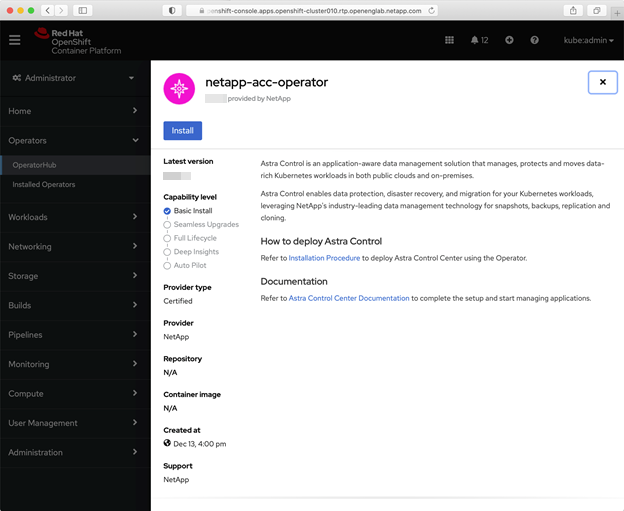Install Astra Control Center using OpenShift OperatorHub
 Suggest changes
Suggest changes


If you use Red Hat OpenShift, you can install Astra Control Center using the Red Hat certified operator. Use this procedure to install Astra Control Center from the Red Hat Ecosystem Catalog or using the Red Hat OpenShift Container Platform.
After you complete this procedure, you must return to the installation procedure to complete the remaining steps to verify installation success and log on.
-
Before you begin installation, prepare your environment for Astra Control Center deployment.
-
From your OpenShift cluster, ensure all cluster operators are in a healthy state (
availableistrue):oc get clusteroperators
-
From your OpenShift cluster, ensure all API services are in a healthy state (
availableistrue):oc get apiservices
-
You have created an FQDN address for Astra Control Center in your data center.
-
You have the necessary permissions and access to the Red Hat OpenShift Container Platform to perform the installation steps described.
Download and unpack the Astra Control Center bundle
-
Download the Astra Control Center bundle (
astra-control-center-[version].tar.gz) from the NetApp Support Site. -
Download the zip of Astra Control Center certificates and keys from the NetApp Support Site.
-
(Optional) Use the following command to verify the signature of the bundle:
openssl dgst -sha256 -verify astra-control-center[version].pub -signature <astra-control-center[version].sig astra-control-center[version].tar.gz
-
Extract the images:
tar -vxzf astra-control-center-[version].tar.gz
Install the NetApp Astra kubectl plugin
The NetApp Astra kubectl command line plugin saves time when performing common tasks associated with deploying and upgrading Astra Control Center.
NetApp provides binaries for the plugin for different CPU architectures and operating systems. You need to know which CPU and operating system you have before you perform this task. On Linux and Mac operating systems, you can use the uname -a command to gather this information.
-
List the available NetApp Astra
kubectlplugin binaries, and note the name of the file you need for your operating system and CPU architecture:ls kubectl-astra/
-
Copy the file to the same location as the standard
kubectlutility. In this example, thekubectlutility is located in the/usr/local/bindirectory. Replace<binary-name>with the name of the file you need:cp kubectl-astra/<binary-name> /usr/local/bin/kubectl-astra
Add the images to your local registry
-
Change to the Astra directory:
cd acc
-
Add the files in the Astra Control Center image directory to your local registry.
See sample scripts for the automatic loading of images below. -
Log in to your registry:
Docker:
docker login [your_registry_path]
Podman:
podman login [your_registry_path]
-
Use the appropriate script to load the images, tag the images, and push the images to your local registry:
Docker:
export REGISTRY=[Docker_registry_path] for astraImageFile in $(ls images/*.tar) ; do # Load to local cache. And store the name of the loaded image trimming the 'Loaded images: ' astraImage=$(docker load --input ${astraImageFile} | sed 's/Loaded image: //') astraImage=$(echo ${astraImage} | sed 's!localhost/!!') # Tag with local image repo. docker tag ${astraImage} ${REGISTRY}/${astraImage} # Push to the local repo. docker push ${REGISTRY}/${astraImage} donePodman:
export REGISTRY=[Registry_path] for astraImageFile in $(ls images/*.tar) ; do # Load to local cache. And store the name of the loaded image trimming the 'Loaded images: ' astraImage=$(podman load --input ${astraImageFile} | sed 's/Loaded image(s): //') astraImage=$(echo ${astraImage} | sed 's!localhost/!!') # Tag with local image repo. podman tag ${astraImage} ${REGISTRY}/${astraImage} # Push to the local repo. podman push ${REGISTRY}/${astraImage} done
-
Find the operator install page
-
Complete one of the following procedures to access the operator install page:
-
From Red Hat Openshift web console:

-
Log in to the OpenShift Container Platform UI.
-
From the side menu, select Operators > OperatorHub.
-
Select the NetApp Astra Control Center operator.
-
Select Install.
-
-
From Red Hat Ecosystem Catalog:

-
Select the NetApp Astra Control Center operator.
-
Select Deploy and Use.
-
-
Install the operator
-
Complete the Install Operator page and install the operator:
The operator will be available in all cluster namespaces. -
Select the operator namespace or
netapp-acc-operatornamespace will be created automatically as part of the operator installation. -
Select a manual or automatic approval strategy.
Manual approval is recommended. You should only have a single operator instance running per cluster. -
Select Install.
If you selected a manual approval strategy, you will be prompted to approve the manual install plan for this operator.
-
-
From the console, go to the OperatorHub menu and confirm that the operator installed successfully.
Install Astra Control Center
-
From the console within the details view of the Astra Control Center operator, select
Create instancein the Provided APIs section. -
Complete the
Create AstraControlCenterform field:-
Keep or adjust the Astra Control Center name.
-
(Optional) Enable or disable Auto Support. Retaining Auto Support functionality is recommended.
-
Enter the Astra Control Center address. Do not enter
http://orhttps://in the address. -
Enter the Astra Control Center version; for example, 21.12.60.
-
Enter an account name, email address, and admin last name.
-
Retain the default volume reclaim policy.
-
In Image Registry, enter your local container image registry path. Do not enter
http://orhttps://in the address. -
If you use a registry that requires authentication, enter the secret.
-
Enter the admin first name.
-
Configure resources scaling.
-
Retain the default storage class.
-
Define CRD handling preferences.
-
-
Select
Create.
What's next
Verify the successful installation of Astra Control Center and complete the remaining steps to log in. Additionally, you will complete the deployment by also performing setup tasks.



